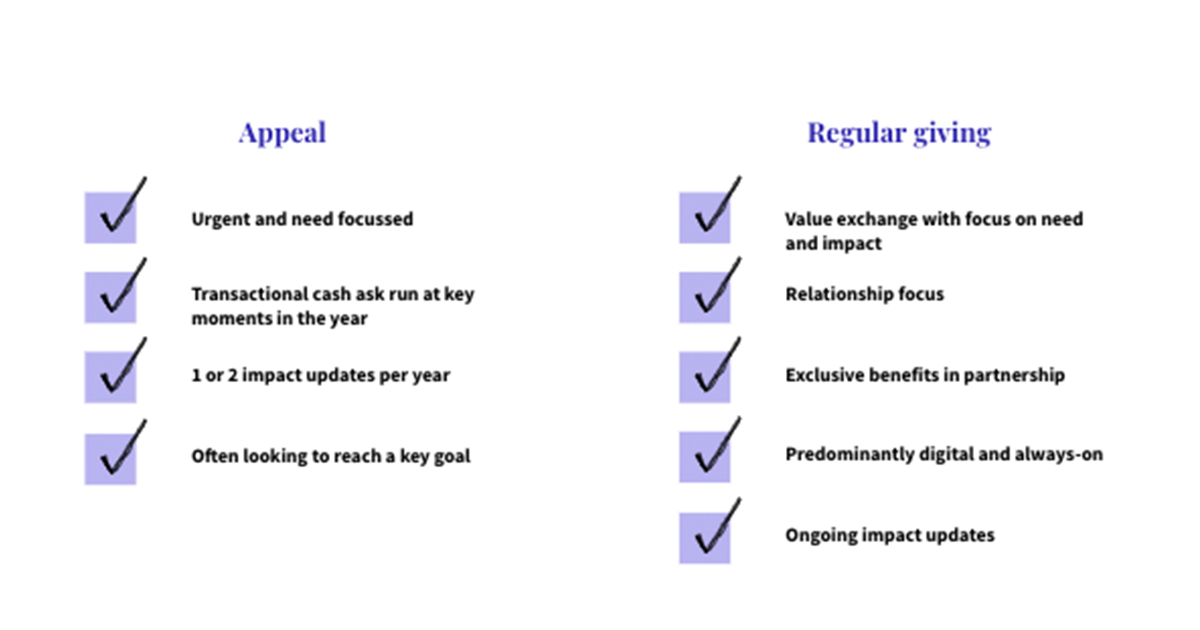How to make your regular giving product a success

There’s been an irreversible shift in the market towards subscriptions.
Netflix, Spotify, the Adobe Suite, car ownership, and everything in between — the subscription model is on the rise. Just look at these stats:
80% of customers demand new consumption models like subscription services
70% of Aussie businesses will be moving to a subscription model in the next two years
Australians are paying an average of $660 in monthly subscriptions.
The subscription model is also impacting the not-for-profit sector in the form of regular giving. Regular giving is the fastest growing donation type, having grown over 170% in the last 10 years. And regular donors are worth 4x more than cash donors. On average, this product makes up approximately 30% of fundraising revenue for Australian organisations.
But regular giving isn’t just a ‘monthly’ switch on your donation page or a checkbox in your direct mail pack. It should be its own dedicated experience that fosters community, retention and growth. That means it should have a strong value proposition and use a diverse channel mix.
Here are 3 key elements of building a successful regular giving product that brings sustainable revenue to your organisation.
1. Nail your value proposition
It’s not enough to ask your donors to give regularly without explaining what they’ll get out of it and why you need that ongoing funding. That’s where your value proposition comes in.
The value proposition for your regular giving product should be different from your other appeals or campaigns.

The difference between regular giving and appeals
Here are a few ways to communicate the value of your regular giving product:
1. Outline why sustainable funding is needed
The strongest value proposition comes alive in your case for support. Be clear in why the donor should donate regularly to you. What does it mean for your organisation and program recipients? It should be unique to your cause and stand separately from your once-off donor messaging. Here are some good examples:
OCRF’s The Lab: Providing regular funding means researchers spend less time writing grant applications and more time working on life-saving research.
Fred Hollows: Regular funding is the most effective way to end avoidable blindness by funding long-term projects like training, education and hospitals.
2. Show the impact it will make
Your regular givers sign up because of the impact they can make. Your impact should be front & centre of your value proposition. Also remember that it shouldn’t be bottled up in a once-per-year newsletter or annual report, but instead should be demonstrated in regular touch points across multiple channels.
3. Explain how the experience will be different from a once-off donation
The point here is to make the donor feel special. Regular giving should be a two-way street, you must give back to keep the donor connected, and invested, and remind them why they should continue their support. Some ways this can come alive include:
Exclusive content that demonstrates impact
Early access to news or advocacy breakthroughs
Community events or forums for subscribers
Behind the scene access
Think about this: there is more dedication required from your donors to give monthly versus once-off, so the value in giving monthly should be higher, too. This will help not only with acquisition of new regular donors, but with retention too.
2. Use a strong and diverse channel mix
When acquiring new donors for regular giving, it’s important to have a diverse channel mix across digital, face-to-face, telemarketing and direct mail. While face-to-face is still the strongest acquisition channel, it has the lowest retention rates. We’ve also seen the rise of telemarketing and digital as priority acquisition channels.
Ultimately your choice of channel should consider the profile of your regular donors. People who give regularly tend to be younger than traditional donors, between the ages of 25 - 55 years old. And the hallmark of these generations? They’re digital natives.
Gen Y and X are more likely to give regularly. Source: Adapted from ntegrity’s research and McCrindle’s 2021 Australian Communities report.
You should also test both direct asks and lead generation as pathways into your regular giving program.
When it comes to direct tactics, trial a dedicated regular giving appeal, build out a dedicated regular giving page that clearly articulates your value proposition, and test prioritising monthly giving over single asks.
Fred Hollows foundation clearly articulates the value proposition on their landing page. Source: Fred Hollows Foundation
For lead generation, trial different tactics such as advocacy, quizzes or downloadables. But make sure you keep a close eye on conversion rates into your regular giving program and ensure the lead generation resource is relevant to your audience. A gimmicky campaign won’t be great for a high barrier ask, unless there’s a long conversion funnel.
The pandemic showed us the importance of diversifying your channels. Make sure your regular giving product is bolstered by a multi-channel strategy.
3. Build a value chain for your donors
Finally, remember that your regular giving product does not sit in isolation, but should work with your other products such as once-off giving and middle and major donor programs.
Regular giving is the natural progression from once-off giving, so aim to target specific behaviours like:
Early in the new donor email welcome series
After their second gift
People who have donated on multiple years
After 3+ gifts within 12 months
Those who have a lower average gift (don’t convert mid-level to monthly)
You can also target direct acquisition in annual regular giving appeals or off the back of campaigns and emergency appeals.
This will make sure you grow your donor value over time.
Ultimately, your regular giving product should stand on its own. It should be its own brand with its own value proposition. This is what will build sustainable revenue for your organisation.
To learn more about how to build your regular giving product from the ground up, download our FREE guide.